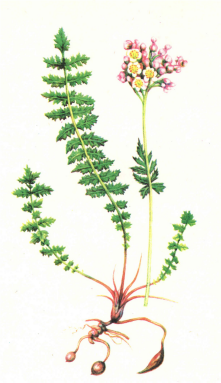A perennial herbaceous plant with a characteristic root system: the rhizome is short, obliquely growing, black-brown on the outside and pinkish in fracture, with numerous thin roots up to 15 cm long. Some roots swell locally, forming spindle-shaped or spherical tuber-like thickenings. The leaves are of two types: basal leaves, larger in shape, oblong with deeply dissected lobes, and stem leaves, smaller with fewer lobes. The inflorescence is terminal, forming a dense panicle; flowers are small, white, with six petals. It blooms from May to July and bears fruit from July to August.

This species is very common, predominantly found in the middle and southern regions of the European part of Russia, as well as in Western and Eastern Siberia, in steppes, dry meadows, forest clearings, and forest edges.
The tubers contain up to 36% tannins, while the leaves have about 14%. The leaves also contain a glycoside that releases salicylaldehyde. A small amount of vitamin C has also been found.
The raw material used consists of cleaned and dried rhizomes with roots of Filipendula hexapetala — Rhizoma et radices Filipendulae hexapetalae.
The rhizomes with roots have astringent properties.
Further north, in the forest zone, Filipendula ulmaria L. (Meadowsweet) is widespread in moist open areas. This plant is taller and more robust, with large, pinnately lobed leaves. Its inflorescence forms panicles with five-petaled flowers. The rhizomes are larger, but the roots do not form tubers. The leaves and especially the root system are rich in tannins and are used as an antidiarrheal, while the flowers contain methyl salicylate.
